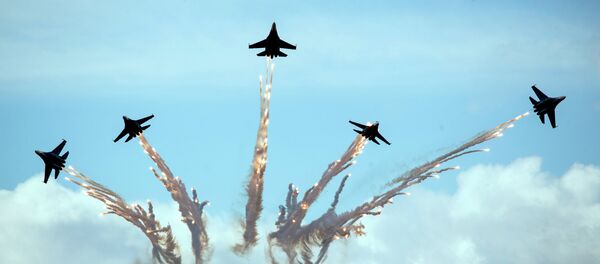The Lockheed Martin F-35 Lightning II is not a maneuverability airplane and it was not designed for close combat, National Defense magazine quoted head of the Air Force's Air Combat Command General Herbert Carlisle as saying.
For a trillion dollars we could have solved oil dependency or financed every American's college tuition or or or… #F35fail #DoD #military
— Barrett Lyon (@BarrettLyon) 1 июля 2015
But this statement runs contrary to what the US Air Force and Lockheed Martin, the developer of the plane, used to say about the fifth-generation stealth plane. They tried to present the F-35 as more effective in air combat than other aircraft in the US arsenal.
"By mid-2015, evidence was mounting that the heavy, complex Joint Strike Fighter – which the Pentagon expects to attack targets on the ground and in the air with equal aplomb – can't turn or accelerate fast enough to win in a dogfight against current fighters, to say nothing of future fighters that might be even more maneuverable," defense analyst David Axe observed.
The inability to survive an aerial fight at close quarters might not seem like a big deal. After all, the most expensive piece of military hardware ever built was designed to perform long distance tasks.
So the new 400 billion dollar F-35 lost in a dogfight against the F-16, its predecessor ��������
— Leary (@con_of_nor) 4 сентября 2015
But consider this: the Lockheed Martin F-35 Lightning II is meant to replace approximately 90 percent of America's tactical air fleet at a time when China and Russia are actively developing advanced dogfighters.

The Pentagon might think that the aircraft will not be engaged in close fighting but history offers an example of how these hopes could be shattered.
Almost half a century ago the F-4 Phantoms were sent on missions in Vietnam without the guns needed for dogfights because the US Defense Department did not think it was necessary. Nevertheless, they found themselves fighting at close quarters against North Vietnamese MiG-21s and losing.
"In trying to do everything – fighting in the air, making bombing runs, launching from aircraft carriers and even taking off vertically from small assault ships while also avoiding enemy radars – the F-35 combines a lot of contradictory design elements," Axe observed.
The US Air Force and Lockheed Martin have been adjusting their message on what the F-35 is truly optimized to do since July.
But with the recent "admission that the Joint Strike Fighter isn't much of a dogfighter, the government's subtle backpedaling from mid-summer has taken a nastier, more defensive tone," the defense analyst noted.
The Pentagon wants a head to head test between the A-10 and the F-35 in close air support. I can guess the winner already.
— Call me TJ (@TonyJWriter) 1 сентября 2015




